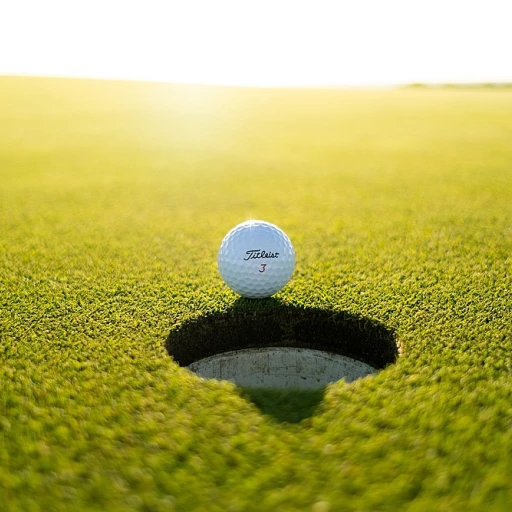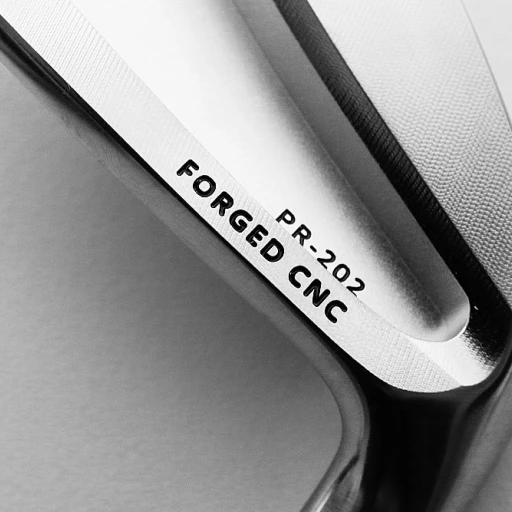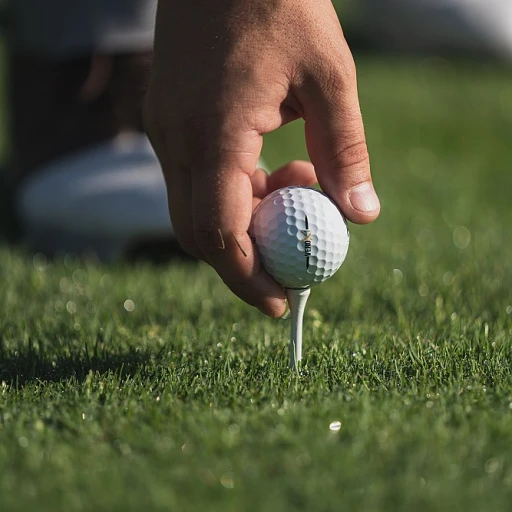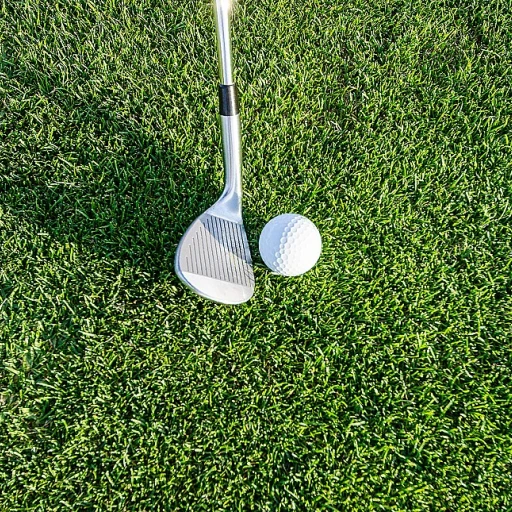
Understanding the fundamentals of driving a golf ball
Grasping the basics: getting started with driving
Driving a golf ball can seem like a daunting task, especially if you're new to the game or trying to improve your drive. However, understanding the fundamentals is the first step toward mastering this crucial aspect of golf.
First off, let's talk about the role of your stance and your grip. Professional golfers stress the importance of positioning your feet shoulder-width apart with your weight evenly distributed. This balanced stance can significantly affect your swing path and the resulting drive distance.
A report from the Journal of Sports Sciences revealed that stance and posture account for approximately 40% of a golfer’s driving performance. Additionally, a correct grip on the club will improve your control and enhance the power behind each swing.
Another important factor is your swing mechanics. Golf instructor Mike Malaska highlights that poor swing mechanics are one of the leading reasons for inconsistent drives. According to Malaska, “When your swing path is not aligned correctly, it’s nearly impossible to hit the ball straight and achieve optimal distance.”
Club selection should not be ignored either. While the driver is commonly used for long-distance shots, it's essential to understand which club suits you best for different scenarios. Club head speed is crucial for long drives and can be improved with practice and some strength training.
The next crucial aspect to master is the pre-shot routine. This routine helps you mentally prepare and physically align yourself for a successful drive. Golfers often overlook this step, but it’s a key part of building consistency in your game.
In our next section, we’ll delve deeper into perfecting your grip and ensuring you hold the club like a pro. You can learn more about gripping techniques and how they influence your shots by checking out our detailed guide: how to swing a driver.
Perfecting your grip: holding the club like a pro
Perfecting your grip: holding the club like a pro
The importance of a consistent grip
Learning how to drive a golf ball effectively starts with a solid grip. It's the foundation that connects your body movements to the club. Experts agree that a consistent grip can improve accuracy and distance significantly. In fact, according to research by the United States Golf Association (USGA), over 80% of top players use a similar gripping technique.
Common grip styles
There are several gripping styles favored by professionals:
- Vardon/Overlap grip: Popularized by Harry Vardon, this involves overlapping the little finger of the trailing hand between the index and middle finger of the lead hand. It's preferred by golfers with larger hands.
- Interlocking grip: Used by legends like Jack Nicklaus and Tiger Woods, this grip involves interlocking the little finger of the trailing hand with the index finger of the lead hand, offering more control and comfort for many players.
- Ten-finger grip: Often used by beginners or players with smaller hands, this grip involves all ten fingers touching the club, similar to holding a baseball bat.
Hand placement and pressure
Regardless of the style, consistency is key. Experts like David Leadbetter emphasize the importance of both hand placement and grip pressure. Position your hands correctly: the club should lay diagonally across the fingers of your lead hand, not your palms, allowing for a more natural motion. The trailing hand should cover the lead hand’s thumb.
Grip pressure matters too. According to Leadbetter, approximately 70% of pressure should come from the last three fingers of the lead hand and the two middle fingers of the trailing hand. Too tight a grip can restrict wrist movement, reducing your club head speed, whereas a grip that’s too loose can lead to inconsistent ball striking.
Practice tips from the pros
To embed your grip into muscle memory, practice is essential. Golf instructor Hank Haney suggests practicing your grip daily, even at home. Hold the club and check your hand positions in front of a mirror to ensure they're correct.
Additionally, Wimpy Rutherford, a PGA professional, recommends a pre-shot grip routine. Before each shot, re-grip the club to ensure your hands are in the proper position. This routine helps make the correct grip feel natural and automatic during your game.
Mastering your stance: the foundation of a great drive
Finding Your Best Stance and Ball Position
A great golf drive starts with your stance. Imagine your feet being the strong base of a pyramid. Your shoulders should align with your feet so they’re about shoulder-width apart. It gives you the stability to swing and hit the ball efficiently. Weight needs to be evenly distributed between both feet, not falling too much on your front or back foot. Golfers often miss this and end up losing power. Expert John Jacobs, a seasoned golf instructor, suggests, “Your stance is your foundation; get it right, and your drive will work itself out.”
Ball Position: The Key to Consistency
Ball position is equally critical. The ball should sit just inside your front heel, in what's called a 'ball forward stance.' This placement ensures that the club strikes the ball right after bottoming out, leading to maximum speed and distance. Many golfers mistakenly place the ball too far back, resulting in poor swing mechanics and less drive distance. Aligning the ball properly will help improve your accuracy and hitting consistency.
Tee Height and Ball Contact
When setting the tee, the height matters. A common rule of thumb is to tee the ball so that half of it sits above the club head when you rest your driver. Teeing the ball higher allows for an upward strike on the ball, translating to longer drives. Studies show that an optimal tee height can increase driving distance by up to 20%. Your goal is to make contact with the ball on the upswing, propelling it into a perfect trajectory.
Visualizing the Target
Align your feet, hips, and shoulders toward your target. Visualizing a line from your ball to the target helps set this alignment naturally. Taking time to fix this alignment will drastically improve your swing path and ultimately result in a more powerful golf swing.
For more expert tips, check out this informative guide on advanced bunker techniques.
The swing path: achieving a smooth and powerful motion
Finding your ideal swing path
Alright, let's talk about the swing path. Ever watched a pro hit the ball and wondered, ‘How do they make it look so easy?’ That's what we're diving into here. Your swing path is the highway your club travels on to contact the ball, and having an ideal one is pivotal.
First off, a study from GOLF.com highlights that top golfers keep their swing paths consistent. A small tweak in your swing’s direction can take you from slicing it horrible to hitting it straight down the fairway. Consistency is vital!
The role of your body in the swing path
Your swing path isn't just about your arms. It's a full-body experience. Think of your body like a synchronized machine. The shoulders, hips, and legs need to move together. Experts like Michael Breed often emphasize the synchronized motion, suggesting that good body rotation is half the battle won.
One key part is ensuring your shoulders and hips rotate smoothly. This means engaging your core and maintaining good posture throughout your swing. Your feet, being shoulder-width apart, and weight evenly distributed, help in achieving this stability.
Tips from experts
Expert advice frequently focuses on drills to groove a good swing path. For example, PGA instructor Rick Smith suggests practicing with alignment rods. Place two rods or clubs on the ground parallel to your target line to reinforce the path your club should follow.
Common mistakes to avoid
Even seasoned golfers fall into pitfalls with their swing paths. A common problem is overcomplicating the motion. Many amateurs struggle by trying too hard or changing grip club during the swing. Instead, the swing should feel fluid and natural.
A helpful visualization comes from Golf.com where they compare the ideal motion to a pendulum. That's the kind of smooth, repeatable motion you’re aiming for. It's important to avoid 'coming over the top'—a term used when the club travels too steeply on the downswing, causing slices.
Practical drills to refine your swing path
Refining that ideal swing path comes down to practical drills. Drills suggested by various golf instructors often include the “pump drill,” where you practice in slow motion to ingrain the proper path.
Another fun drill is tee drills. Place a tee where you want the bottom of your swing to be and practice hitting the tee out of the ground without a ball. This helps in understanding where your club should travel and where your contact point should be.
Generating club head speed: tips for increasing power
Understanding How Club Head Speed Impacts Your Game
Generating club head speed is where the rubber meets the road in the drive game. It ain't just about strength, though that helps; it's about technique, timing, and a proper understanding of how to wield that driver. You ever seen pros hit those balls 300+ yards and thought, “How in the world?” Well, part of the magic is in the speed of the club's head.
The Science Behind Club Head Speed
To really break it down, increasing club head speed is all about applying more force over the shortest time span. According to a Golf Digest report, pros can achieve up to 120-130 mph speeds. Regular golfers? More like 85-105 mph. Every 1 mph increase in club head speed can enhance the driving distance by roughly 2.5 yards.
Sean Foley, coach to PGA Tour stars, underscores the importance of utilizing rotational force efficiently. “It’s about your body's ability to transfer energy from the ground up through your body, all the way to the club,” he explains.
Tips and Techniques to Boost Your Speed
Ready to boost your club head speed? Here are some actionable tips:
- Strength Training: Squats, deadlifts, and other compound lifts can build lower body strength, which is critical for power transfer. Strengthening your core is also essential.
- Flexibility Drills: Staying limber helps maximize your swing arc. Try yoga or focused stretching on hip flexors and shoulders.
- Proper Grip: Your grip plays a significant role in speed. Make sure your grip is solid but relaxed (if you missed it, go back to the earlier part on perfecting your grip).
- Sequence of Motion: Ensure your swing starts from the ground up. Legs and hips initiate followed by your torso and finally, the arms and club.
- Club Fitting: A custom-fitted driver can make a helluva difference. The right shaft length, loft, and weight distribution can enhance your natural speed.
Case Study: Tiger Woods
Tiger Woods’ ability to generate exceptional club head speed has made headlines throughout his career. Experts agree that his precise technique and rigorous strength and flexibility training have been instrumental. His club head speed often peaked at around 125 mph, enabling incredible drives consistently.
Wrap it Up
So, if whacking that little white ball further and straighter is your goal, focus on generating more club head speed. Get your technique tight, train smart, and remember—sometimes less force, more finesse does the trick.
Ball position and tee height: optimizing your setup
Making setup adjustments for optimal ball position
Getting your ball position right can be the game changer. Too far back or forward can mess up your swing path and power. Charles Howell III, a pro on the PGA tour, says, “a consistent ball position is crucial for a solid drive.” For drives, your ball should just be inside the left heel. This frees up your swing, helping those long shots soar.
Tee height: finding the perfect balance
Adjusting tee height is also key. According to a study by Golf Digest, around 71% of golfers tee up the ball too low. A higher tee helps you hit up on the ball, maximizing distance. Aligning the ball with the sweet spot of your driver’s clubface can boost your driving distance significantly. Tiger Woods suggests half the ball should be above the clubhead at address.
Prepping with a consistent pre-shot routine
Rehearsing a pre-shot routine not only calms your nerves but sets the stage for a consistent swing. Steps might include aligning yourself to the target, a few practice swings, and a deep breath to focus. According to sports psychologist Dr. Bob Rotella, “Having a routine puts you in the same state before every drive.”
Optimizing your setup with proper ball position and tee height can seriously improve your game. Fina-tuning these aspects lets you smash those long drives like a pro.
Pre-shot routine: preparing for a successful drive
The importance of a pre-shot routine
Eager to launch a drive that sails long and true? One secret weapon most golfers overlook is the pre-shot routine. This isn't just about setting up to the ball; it's about mentally preparing and zoning in on your target.
According to renowned golf instructor Hank Haney, a solid routine can be your best ally in consistently driving well. In fact, about 85% of professional golfers credit their pre-shot routine for their consistent performance on the course (source: PGA Tour Reports).
Mental focus and visualization
Your mind plays a huge role in how you hit the ball. Before addressing the ball, take a moment to visualize your desired shot. Picture the ball soaring through the air, landing exactly where you aim.
The late, great Arnold Palmer often spoke about the power of visualization: 'I never hit a shot, even in practice, without having a very sharp, in-focus picture of it in my head' (source: Arnold Palmer Quote). This tip isn't just for seasoned pros; amateurs can reap the benefits too.
Setting up: alignment and stance
With your mind in the game, it's time to set up physically. Stand behind the ball, pick a specific target in the distance, and align your clubface accordingly. Then, position your feet shoulder-width apart with weight evenly distributed. This stance promotes better balance and stability, crucial for a powerful drive.
Remember, the grip is key too—if you need a refresher, check out our detailed guide on mastering the art of a perfect swing.
Practice makes perfect
Finally, repetition is king. The more you stick to your routine, the more second-nature it becomes. Spend some time on the range working through your pre-shot routine until it feels automatic. You'll notice a significant improvement in your performance and confidence on the golf course.
With these tips, crafting a solid pre-shot routine can be a game-changer. So next time you hit the links, give your routine the attention it deserves and watch your drives soar farther and straighter.


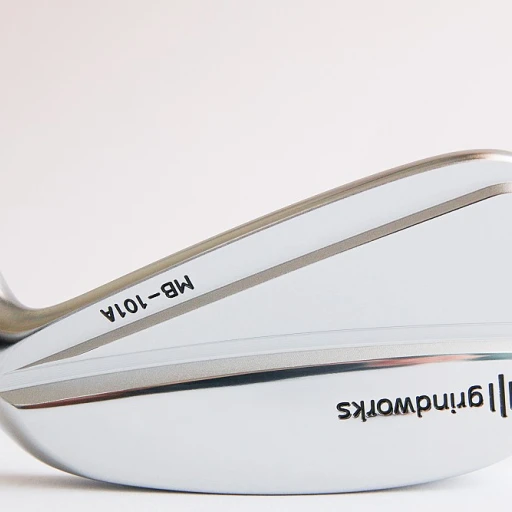

-large-teaser.webp)



